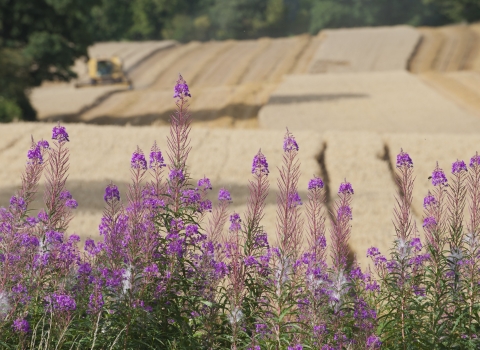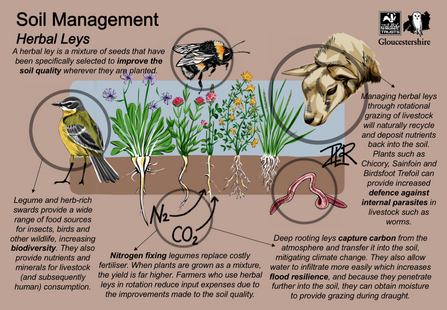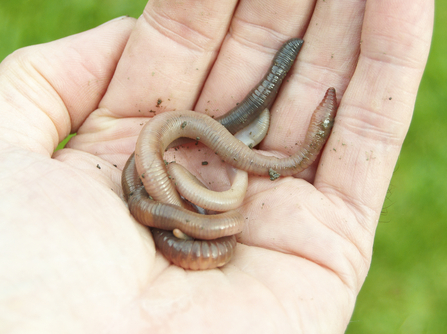Increasing natural soil health; building a foundation for wildlife to thrive
Soil is a fundamental natural resource on which life depends. It provides many essential services on which we rely including food production, water management and support for valuable biodiversity and ecosystems. As a large store of carbon it also plays a vital role in the fight against climate change.
The UN has warned that the world’s soils face exhaustion and depletion, with an estimated 60 harvests left before they are too degraded to feed the planet. A UK 2014 study found that matters are not much better, estimating 100 harvests remaining.
Our soils have degraded over the last 200 years due to intensive agricultural production and industrial pollution. Soils in England continue to face three main threats:
Soil erosion by rain and wind. Erosion affects both the productivity of soils but also water quality and aquatic ecosystems.
Compaction of soil reduces agricultural productivity and water infiltration, and increases flood risk through higher levels of run off.
Organic matter decline. The loss of soil organic matter reduces soil quality, affecting the supply of nutrients and making it more difficult for plants to grow, and increases emissions to the atmosphere.
All these threats may be magnified by climate change. Safeguarding our soils for future generations means managing them better, reducing degradation and building resilience to increasing pressures.

Paul Harris
Soil Health
Healthy soils are vital to grow food, help store carbon that mitigates against climate change, hold back floodwater and support a wealth of biodiversity from fungi to earthworms. Any land management business is dependent on good soil health and if soils are continually degraded through damaging land management practices then we will not be able to grow food or drink clean water. Similarly, if the natural fertility of our soils is reduced then insect populations and other wildlife will not be supported, and populations will continue to decline.
To help restore the natural health of our soils we encourage farmers and landowners to adopt good soil management practices, for example: increasing organic matter, sound rotations and maintaining cover. We can provide advice on crop rotations, tillage practices and soil management to reduce crop input costs and to build soil organic matter. A healthy soil has positive implications to both biodiversity and carbon capture. A healthy, high organic matter soil will have lower growing costs, require less inputs, have lower cultivation costs and enhanced crop yields so is more profitable.
Herbal Leys
Soil is arguably the most important asset that a farmer or landowner possess. However, our soils are in crisis and we urgently need to implement solutions to help restore our soils to a healthy state. Improving soil management can be achieved through making the right land management choices.
One such strategy that can be employed to help provide a favourable environment includes using a herbal lay within a crop rotation. A herbal ley is a complex seed mixture of grass, herb and legume species that have traditionally been used to build soil fertility and structure in arable rotation. Introducing herbal leys into a crop rotation can produce significant benefits for soil health, but also to livestock health and the wider environment.

Imogen Robertson
Key benefits to local communities
Along with producing commercial products, agriculture delivers societal public goods such as water regulation, erosion control, resilience to floods and climate change mitigation. When farmers and land managers employ techniques that have catchment scale impacts this can bring about improvements to drinking water quality or reduce flood risk in towns and villages.
Deep-rooting leys can have wider societal benefits through capturing carbon from the atmosphere and transferring it into the soil, helping to mitigate against climate change. Another benefit of plants with deep roots is that they can penetrate further down into the soil to draw up moisture, providing grazing for livestock during periods of drought. Herbal leys also improve soil structure which helps to increase flood resilience as deep-rooted plants enables water to infiltrate the soil more easily.

Imogen Robertson
Key benefits to farmers
Farmers who use herbal leys in rotation spend less on inputs, thanks to the improvements they make to the soil. Managing herbal leys through rotational grazing of livestock will naturally recycle and deposit nutrients and organic material back into the soil. Plants such as Chicory, Sainfoin and Birdsfoot Trefoil can provide an increased defence against internal parasites. When plants are grown together in a mixture they yield more than their average due to overlapping growth habitats and patterns. Legumes replace costly fertiliser as they naturally produce Nitrogen that they release into the soil, which benefits the growth of other plants.
Key benefits to biodiversity
A herbal ley not only increases soil quality but also increases soil life. Healthy soils provide a dynamic ecosystem for micro-organisms, such as bacteria and fungi, that break down pollutants and convert organic matter into accessible nutrients. Legume and herb rich swards provide a wide range of food sources for insects, which are crucial to farming as they pollinate crops, while also helping to control harmful pests.
Earthworms are good indicators of soil health as they play an important role in returning carbon dioxide to the soil. Furthermore, they incorporate oxygen and organic matter into the soil and help support soil structure. Healthy soils underpin the whole food web and are critical to supporting more visible wildlife, such as birds and mammals.

Alan Price

